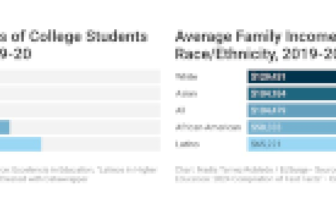Why Schools Still Struggle to Provide Enough Mental Health Resources for Students

[ad_1]
While the mental health of students remains a top concern of many in the education field, federal data reveals that it’s not all bad news. Or at the very least, not getting worse in all areas and potentially improving in some.
The National Center for Education Statistics released its biennial Crime, Violence, Discipline, and Safety in U.S. Public Schools report covering the 2021-22 academic year. It uses survey responses from principals of nearly 2,700 P-12 schools to take the pulse of myriad issues that affect students and how schools operate.
Nearly 90 percent of schools reported increased social and emotional support for students during the 2021-22 academic year.
However, 39 percent of schools reported that lack of access to licensed professionals and mental health funding were major roadblocks to their efforts supporting student mental health. During that same time period, the U.S. Department of Education says that $275.7 million of emergency school funds were spent on mental health support for students and staff.
While conversations about the importance of student mental health have become abundant since the onset of the COVID-19 pandemic, Amir Gilmore points out that there are still a myriad of reasons why schools don’t have enough resources for the kind of support framework they need. Gilmore is associate dean of equity and inclusion for student success and retention at Washington State University’s College of Education.
There are, of course, workforce barriers like the time-consuming mental health professional pipeline and a lack of availability of candidates in any one region. Many schools have just one mental health professional, Gilmore explains, who could be the only source of support for hundreds or thousands of students. That’s a recipe for burnout, he says, and doesn’t touch on the need for counselors who are equipped to work with students of color or students with disabilities.
“We also are facing this kind of crisis where we don’t have enough teachers in schools to really work with students,” Gilmore says, “but then we also just don’t have enough mental health professionals, either. Everyone is just really stretched thin.”
That invariably puts the onus back on teachers to handle student mental health issues. Gilmore posits that placing that responsibility on teachers’ shoulders adds to the strain of their day-to-day work rather than solves the problem.
“Do we talk about mental health? Do we talk about SEL a lot in schools and teacher preparation programs? Yes, but the teacher cannot be everything, right?” Gilmore says. “They cannot wear so many different hats, and it’s just not a very sustainable process for them, either.”
Despite the recent effort and money put toward alleviating the mental health workforce’s shortages, “it will likely take years to fully ensure every student has access to [mental health] professionals and proper support,” Kelly Vaillancourt Strobach, policy and advocacy director at the National Association of School Psychologists, told EdSurge via email interview.
Her organization recommends schools maintain a 1:500 ratio of school psychologists to students, but Vaillancourt Strobach notes that the national average is more than double — going beyond a 1:2000 ratio in some school districts. In some regions, the shortage means that students who struggle to access care at school might likewise have trouble finding mental health professionals in their communities, she adds.
“We know many districts wanted to use ESSER funds to hire more staff, but workforce shortages prevented them from doing so,” Vaillancourt Strobach says, referring to the Elementary and Secondary School Emergency Relief Fund. “What we are hearing is that some districts are worried that they will not be able to sustain services or retain staff once ESSER funds have expired.”
The deadline to spend pandemic relief funds has indeed started the countdown to the end of some school-based services. With no additional mental health money allocated by the state of Texas, for example, Houston’s school district will lose seven “intensive mental health specialists” after funds run out. In another part of the country, the “funding cliff” threatens a program in Denver that added mental health providers to 10 schools.
Another challenge is that even if society is generally coming to realize the importance of mental health, Gilmore adds, some educators — be they administrators or teachers — simply aren’t bought into the idea that it needs to be a priority.
That extends to the community level. Not every voter or parent in a given school district is necessarily supportive of setting aside more money for student mental health services, he says, and its pedagogical cousin social-emotional learning has been politicized similarly to critical race theory.
“I think in those moments when we highly politicize things, we forget that it’s about students at the end of the day,” Gilmore says. By pushing back against social-emotional learning in schools, “some parents or some pundits could say that, ‘We’re doing this for students,’ but I would argue that we are just taking away a lot of more tools and resources for students to just be themselves, to express themselves. In a lot of areas in the life of a child or adolescent, they don’t really have many places to express themselves freely.”

Mental health resources feel the squeeze of other factors outside of schools’ control, Gilmore adds, like the stress of inflation and whether local voters are receptive to increasing a district’s budget.
He has seen the issue play out in his own city of Spokane, Washington.
“Some people in the community are like, ‘No, we don’t wanna invest more money into schools. We don’t want our taxes to go up,’” he says. “Can every taxpayer see the value of having mental health professionals [in schools]? Your mileage is going to vary.”
Just as the scramble to spin up remote learning shined a light on school inequities in 2020, Gilmore says mental health resources — or the lack thereof — continues that now.
“I’m pretty sure that in school districts that have higher incomes, parents in the district will probably be able to fund that,” he says. “But we’re gonna run into the same issue that students and lower-income districts are not gonna be able to have those mental health counselors. We’re running into issues over race and class, and that’s what education is currently right now — it’s very inequitable.”
[ad_2]
Source link







